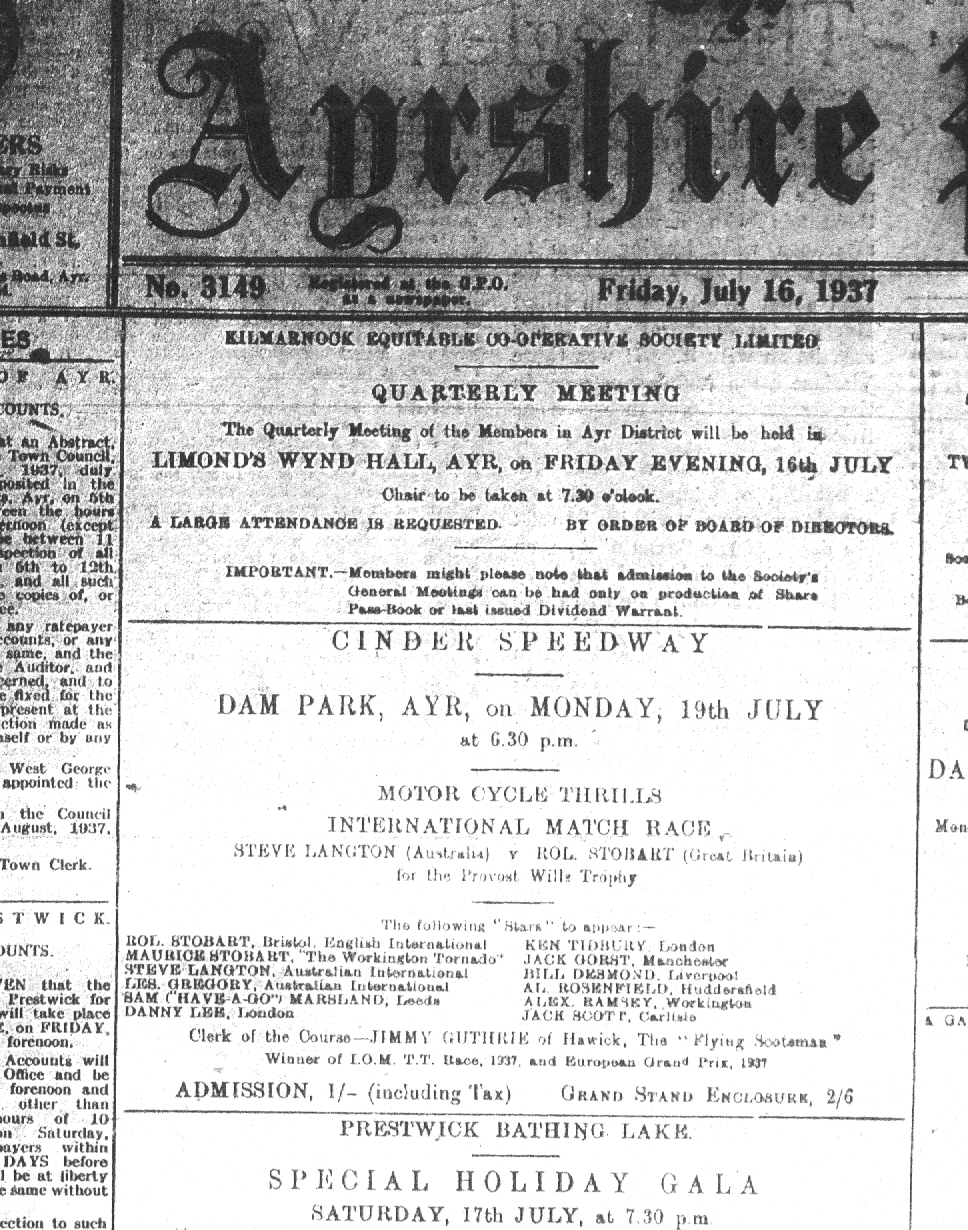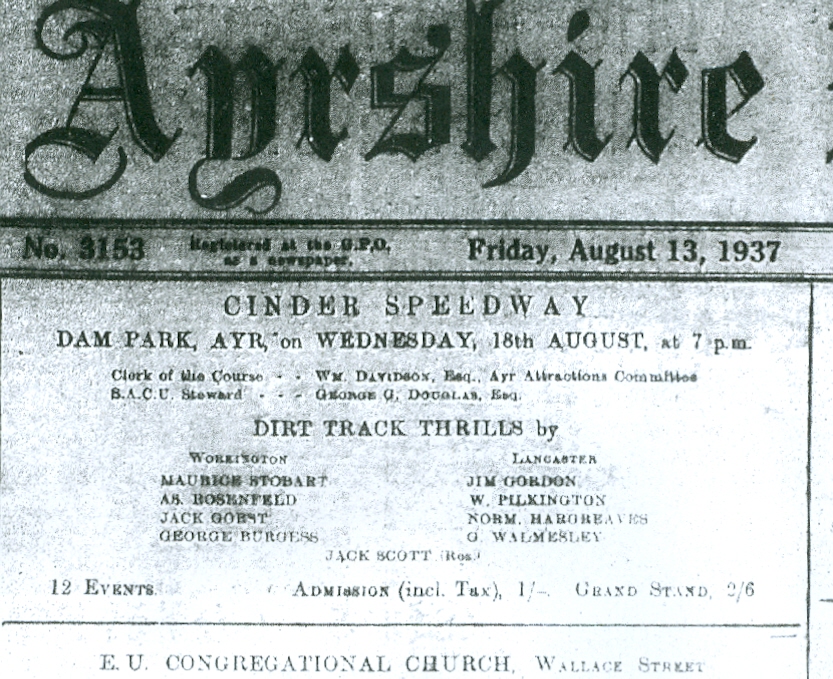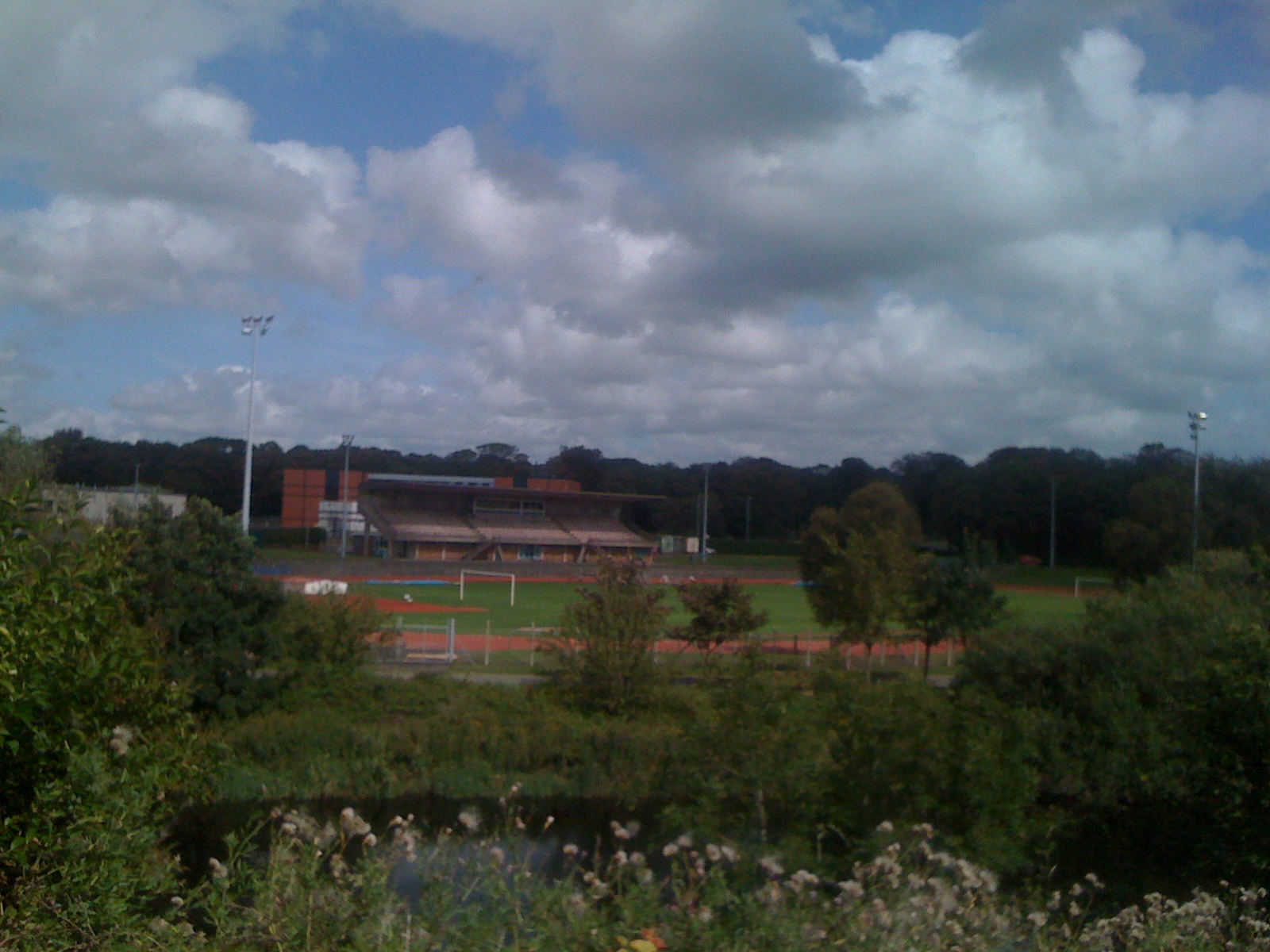Ayr opens
Speedway’s introduction in Scotland was a bit like a firework. It fizzed and gave a great display but very soon had died out. Edinburgh’s Marine Gardens closed in 1930 after crowds fell away alarmingly. Glasgow White City managed to complete their Northern League fixtures the following year before they, too, put the shutters up.
Somewhat surprisingly speedway’s revival north of the border came in 1937 in the coastal town of Ayr, where no racing had previously been staged. There was, however, a fairly active sand track scene, with the gently sloping beach providing an excellent track at low tide. Less surprising was the date chosen for the inaugural meeting, the third Monday in July, known as “Fair Monday” in Glasgow and the West of Scotland, a local holiday taken instead of the August Bank holiday. Traditionally, those not away on holiday would spend the day at one of the many coastal resorts south of Glasgow. Ayr was, and still is, one of the major attractions on this holiday. As well as all the traditional entertainments on offer in Ayr, in 1937 day trippers also had the opportunity to witness “Cinder Speedway” at Dam Park, a mere five minute walk from the train station. With a 6.30 start, there was plenty time to spend the day on the beach and watch the speedway before heading home to Glasgow.

The track was specially prepared for the event, with a safety fence being built and the meeting was the first in Scotland to feature the “fly up” starting gate, a recent innovation pioneered in England.
The Ayrshire Advertiser, previewing the meeting, reported “This will be something new for the people of the Ayr district, and, as there will be a large number of Glasgow people on holiday at the time, there should be a big attendance” ..and so it turned out, with over 5,000 attending the opening meeting.
Fifteen races were held, contested by a dozen riders. Australian Steve Langton beat Roland Stobbart to annex the Provost Wills Trophy. It was a good night for the Hart brothers, both of whom were late substitutes. Stan won the Ayr Scratch Race, while Oliver won the Golden Helmet. The Advertiser reported “There was only one crash. One of the riders came down and the following rider did well to clear his fallen comrade”
The second meeting could not be staged until Wednesday 18th August, probably because there were a number of events, including a circus, already planned at the stadium. The Advertiser told readers “The track is considered by competent judges to be a very good one and it is believed that the sport will gain popularity in Ayr”, so the signs seemed good for a long term future of the sport in the town.
Unfortunately the weather was not kind, keeping the anticipated large crowd down to “considerably less” than expected, possibly only a few hundred. Maybe Ayr was the first track to encounter the “Scottish curse”, that of visitors failing to make the journey north of the border! However, it did afford two locals the opportunity of competing in the team event. It would seem that their bikes were not really up to the task, although both riders acquitted themselves well on borrowed machines.

A full report from the Ayrshire Post of 20th August 1937 follows
Dirt Track Racing at Ayr Speedway
Workington show how it is done.
All the thrills of dirt track racing were forthcoming at the second meeting held at Dam Park Speedway, Ayr on Wednesday evening. Unfortunately the weather was not all it should have been and the rain, which fell previous to the starting time, accounted for the rather poor attendance. As it was, hundreds who did attend were more than might, in the circumstances, have been expected, although considerably less than the sporting nature of the event deserved.
Dirt track racing is not, of course, just simply a matter of riding a motorcycle at speed around a cinder track. The first requirement is a special machine, and the second a very special technique, which not all riders acquire and most take up to seven years to attain. The machines, queer looking contraptions in the eyes of the ordinary man and useless for everyday motorcycling, are not fitted with brakes, and steering at the corners is accomplished by the use of the engine, the turns being taken in a series of skids with the handlebars in the opposite direction to the corners. As had been said, there is no royal road to the achievement of this technique, and most riders are recruited from the ranks of sand-racing enthusiasts. Two of these W. Durward and D. Denny, both members of the Ayr Motor Cycling Club, made their appearances on Wednesday evening but machine troubles in both instances made their debut brief.
The principal item in an interesting and often exciting programme was a contest over six heats between teams from Workington and Lancaster. Unfortunately, two of the latter were not forward, and their places were taken by Durward and Denny. Fastest time in this event was put up in the opening heat, when M. Stobbart, Workington, covered the three laps in 71.2 seconds, but it was not until the final of the scratch race that the fastest time of the evening was recorded. This was 70.4 seconds, attained also by Stobbart. The strain to which machines and riders alike were put was amply apparent in the fourth heat of the team race when A. Butler’s handlebars broke in the second lap. The rider, a member of the Workington team, was able to avoid an accident however, and drove his machine to the base in safety. This team event was won by Workington with 18 points against their opponents’ 16. Lancaster had four firsts and two seconds, while Workington took points with two firsts, four seconds and four thirds.
The scratch event resulted in some fine racing, and made its exciting way through three heats and two semi-finals to the final, in which were M. Stobbart, A. Butler, E. Butler and J. Gorst. Stobbart won the race in record time with A. Butler second and E. Butler third.
Following this a two-laps race between Durward and Denny was arranged, the machines being loaned from other members of the two teams. Denny took the lead almost from the start, and, on what seemed the faster machine, held it until the end. Both riders, however, seemed to enjoy themselves thoroughly and took advantage of the opportunity to run a third lap. Even when Durward came off the track, Denny continued and it was not until he was flagged a second time that he finished his “solo”.
The teams were
Workington – M. Stobbart (Captain), A Rosenfield, J. Gorst and A. Butler
Lancaster – J. Gordon (Captain), W. Durward, E. Butler and D. Denny
The speedway, which might easily become a sporting feature of town activities, is, of course, under the direction of Mr J. Fraser Crichton, president of the Solway and District Motor Club, and the officials on Wednesday evening were
S.A.C.U. steward and judge – George G. Douglas
Stewards – Messrs J.J. Fairbairn, T. Gilchrist, W.A. Davidson and J. Mair
Timekeeper – J. Lees
Chief Pits Marshall – J. H. Saul
Announcer – Bailie Milligan
Lap Scorer – W. Bewley.
Almost certainly, the event ran at a loss and any plans for further meetings during the rest of the season were shelved. In any case, with evenings now drawing in, dusk was approaching by nine o’clock and track lighting would now be required for evening racing. Football ruled out Saturday afternoons, and in these days the sanctity of the Presbyterian Sabbath was strictly observed.
Interestingly, the Clerk of the Course was shown as “Wm Davidson Esq. of the Ayrshire Attractions Committee”. It may well be that this was just an honorary post as Hawick’s Jimmy Guthrie, the Isle of Man TT winner in 1937, filled the role in the opening meeting. It is an intriguing, if unlikely, thought that the council might have funded the speedway! Certainly there was some civic input, as the first meeting featured a match race between Steve Langton and Roland Stobbart for the Provost Wills Trophy, provost being the Scottish equivalent of mayor.
The promoters, whoever they were, may have concluded that viable crowds were only likely to roll up during the holiday season and that there was insufficient interest in Ayr and the surrounding district to support an entire season’s program. You could paraphrase Rhett Butler from “Gone With the Wind” in saying that “Frankly, Ayr didn’t give a Dam (Park)!
Speedway never did return to Ayr, although Ian Hoskins made an application to stage racing at Dam Park for the 1970 season but it was tossed out by the local council.
Planning permission was , however, for the sport at the Whittlets dog track on the northeast periphery of the town over thirty years ago, but nothing ever came of it. Dam Park remains, but is now in the centre of a residential area, and there can be little or no prospect of the sport returning there
